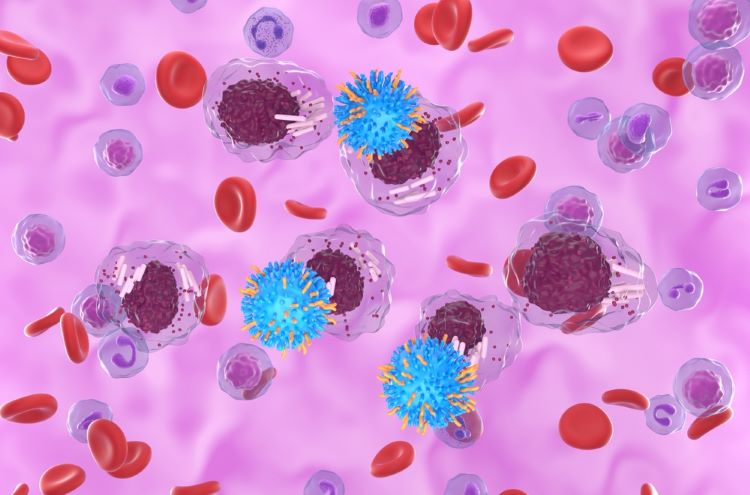Targeted therapies for chronic lymphocytic leukaemia in an evolving treatment landscape
Posted: 15 August 2024 | Dr Mehrdad Mobasher (BeiGene) | No comments yet
Dr Mehrdad Mobasher, Chief Medical Officer for Hematology, BeiGene, discusses the evolution of therapies for chronic lymphocytic leukaemia (CLL), the promise of targeted treatments and what could be on the horizon of the therapeutic landscape for this disease.


Chronic lymphocytic leukaemia (CLL) is the most prevalent adult leukaemia in Western countries with more than 100,000 incidences and more than 40,000 deaths reported globally in 2019.1 The cancer is a slow-growing but potentially life-threatening B-cell malignancy, in which increased activation of B-cell receptor signalling pathways leads to overgrowth of lymphocytes in bone marrow and other disease compartments. Targeted therapies introduced over the last 10 years, such as Bruton’s tyrosine kinase inhibitors (BTKis), which block a B-cell receptor pathway, and B-cell lymphoma 2 inhibitors (BCL2i), which are medicines designed to induce apoptosis (programmed cell death) in cancer cells, have led to a dramatic change in the CLL treatment landscape.
CLL treatment evolution: from chemo-based options to targeted therapies
Targeted treatments introduced over the last 10 years, such as Bruton’s tyrosine kinase inhibitors (BTKi)… have led to a dramatic change in the CLL treatment landscape”
Advances in the understanding of CLL biology have resulted in the development of new therapeutic approaches that have dramatically improved patient outcomes, even prolonging patients’ lives.
BTKis, oral drugs given as continuous monotherapy, have revolutionised the treatment of CLL, with the first generation BTKi ibrutinib receiving European Medicines Agency (EMA) approval in 2014; however, side-effects (such as cardiovascular toxicities2) have limited its suitability.
Second generation BTKi, acalabrutinib, was designed to be more specific against the target to mitigate some of the toxicities associated with ibrutinib and has demonstrated an improved safety profile in head-to-head clinical trial ELEVATE-RR (acalabrutinib vs ibrutinib) but with similar efficacy (non-inferiority trial with hazard ratio (HR)=1.0).
Zanubrutinib, a next-generation BTKi, designed to be more specific, more potent, and provide round the clock inhibition of the target, demonstrated superior efficacy (HR=0.65 for all-comers; HR=0.52 for patients with del(17p)/TP53 mutation) and a favourable safety profile, including cardiac events, compared to ibrutinib (ALPINE study).
Another targeted treatment option is the combination of an oral BCL2i (so far, only venetoclax is approved) with an injectable B-cell targeted immunotherapy, for example, the anti-CD20 antibodies, rituximab or obinutuzumab as tested in the MURANO, CLL14 and CLL13 trials in relapsed/refractory and treatment-naive CLL. Alternatively, a BTKi can be given in fixed duration; these regimens have also shown efficacy benefit over chemo-immunotherapy (GLOW trial).
Continuous and fixed duration targeted therapies – shifting the CLL treatment paradigm in Europe
Continuous targeted therapies approved by the EMA are:
- first generation covalent BTKi: ibrutinib
- second generation covalent BTKi: acalabrutinib
- next generation covalent BTKi: zanubrutinib.
All are orally administered as monotherapy and given continuously until disease progression or unacceptable toxicity.
The approved fixed duration targeted therapies are:
- Venetoclax + rituximab (Ven+R) in relapsed/refractory CLL – this combination requires infusions. Venetoclax is given for 24 months including five-week ramp-up, to reduce risk of tumour lysis syndrome (TLS) followed by six cycles of rituximab.
- Venetoclax + obinutuzumab (Ven+Obi) in treatment-naive CLL – this combination requires infusions. Venetoclax is given for 12 cycles, including five-week ramp-up: six cycles with obinutuzumab, then six cycles alone.
- Venetoclax + ibrutinib (Ven+Ibru) – this combination is oral. Ibrutinib is given as a single agent for three cycles of 28 days, followed by 12 cycles of Ven+Ibru, including five-week venetoclax ramp-up.
Pivotal clinical trials for each treatment include:
Novel BTKi† | |
Relapsed/refractory (R/R) CLL | |
ALPINE3 N=652 | · Zanubrutinib vs · Ibrutinib
Primary endpoint: ORRIRC followed by PFSIRC superiority |
ELEVATE-RR4 N=533 | · Acalabrutinib vs · Ibrutinib
Primary endpoint: PFSIRC non-inferiority |
Treatment-naïve (TN) CLL | |
SEQUOIA5 (Cohorts 1 and 2) N=590 | · Zanubrutinib vs · Bendamustine-rituximab (BR)
Primary endpoint: PFSIRC |
ELEVATE-TN6 N=535
| · Acalabrutinib vs · Acalabrutinib-obinutuzumab vs · Chlorambucil-obinutuzumab (Clb-Obi)
Primary endpoint: PFSIRC |
Fixed duration combinations† | |
R/R CLL | |
MURANO7 N=389 | · Venetoclax-rituximab (Ven-R) vs · Bendamustine-rituximab (BR)
Primary endpoint: PFSINV |
TN CLL | |
CLL148 N=432 | · Venetoclax-obinutuzumab (Ven-Obi) vs · Chlorambucil-obinutuzumab (Clb-Obi)
Primary endpoint: PFSINV |
GLOW9 N=211 | · Venetoclax-ibrutinib (Ven-Ibru) vs · Chlorambucil-obinutuzumab (Clb-Obi)
Primary endpoint: PFSIRC |
INV: investigator-assessed; IRC: assessed by independent review committee; MRD: minimal residual disease; ORR: overall response rate; PFS: progression-free survival. †Arms showing significant primary endpoint efficacy benefit shown in bold.
Development challenges to achieve regulatory approval
Comparative trials of novel agents require large samples and for long-term follow up to adequately show the benefit of one arm over another to gain approval. It can be challenging to enrol patients given that, in areas of rapid advances in treatment like CLL, there are so many ongoing trials of new therapeutic approaches.
Furthermore, standard-of-care comparator arms can quickly become outdated as the landscape evolves, making it difficult for clinicians to base treatment decisions on data upon study read out.
Moreover, regulatory bodies may require demonstration of superiority in later endpoints such as PFS or overall survival (OS) even when intermediate/surrogate endpoints, such as complete response (CR) or undetectable minimal residual disease (uMRD), show improvements.
Factors favouring continuous versus fixed duration treatment for CLL
To date, there are no data from randomised studies comparing continuous treatment to fixed duration targeted treatment but such trials may be planned. While cross-trial comparisons are discouraged, comparing outcomes of subsets of patients in different trials has led to treatment preferences for certain patient populations (eg, BTKis may be preferred in high-risk patients with del(17p)/TP53mut).
Several studies have compared targeted therapy combinations of BTKi and BCL2i versus Ven-Obi, including uMRD guided trials; MAJIC of Ven-Obi vs Ven-Acala; and CELESTIAL-TN CLL comparing fixed duration Ven-Obi vs fixed duration zanubrutinib + novel BCL2i sonrotoclax, which has shown promising safety and efficacy in Phase I/II studies.
Some of the key considerations favouring one approach over the other are shown in the table below.
Favours BTKi continuous therapy | Favours fixed duration combination therapy |
· Patient wants convenience of a simple oral monotherapy regime · Patient prefers continuous treatment (concerned about stopping therapy and that disease may return) · Patient has high-risk disease features (eg, del(17p)/TP53mut) given that BTKis are consistently effective across disease subtypes · Concerns about known safety issues associated with the currently available fixed duration therapies · Need to switch treatment options in case of intolerance but good efficacy, in which case they could switch to another BTKi · Need for sequencing options in case of early disease progression on fixed duration treatment. | · Patient prefers fixed duration therapy · Patient is young and the known safety concerns of fixed duration are less of a consideration (eg, Ven-Ibru is associated with cardiac deaths especially in older patients in GLOW) · Patient has low-risk disease features (eg, Ven-Obi is shown to have shorter PFS in higher risk patients such as those with del(17p)/TP53mut) · Patient doesn’t mind infusions (if Ven-Obi or Ven-R are considered) · Patient can travel frequently to the treatment centre (Ven requires ramp-up & close monitoring in case of toxicity) · Need for sequencing options; possibility of retreatment with fixed duration particularly in cases where BTKis are not an option due to prior progression, mutations or toxicity; or late relapse to earlier fixed duration (although limited data available on outcomes). |
New agents and regimens are continually being approved, shifting the treatment landscape. For example, chemoimmunotherapy now has a smaller role in treating the disease except in cases when all targeted therapy options are exhausted.
Future developments
While great strides have been made in the treatment of CLL, there are new approaches on the horizon that may further improve outcomes for patients…One option is to improve fixed duration combinations”
While great strides have been made in the treatment of CLL, there are new approaches on the horizon that may further improve outcomes for patients.
One option is to improve fixed duration combinations by using novel BTKis in combination with venetoclax, or triple combinations of a BTKi + Ven-Obi, as in the BOVen study of zanubrutinib + Ven-Obi10, which showed durable rates of PFS and undetectable minimal residual disease after long-term follow-up.
These new combinations may mitigate some of the toxicity issues with current fixed duration treatments. The SEQUOIA trial5 included a cohort of patients (Cohort 3) with high-risk CLL or small lymphocytic lymphoma (SLL) (del(17p)/TP53mut) who received a combination of zanubrutinib + venetoclax: preliminary data demonstrated promising efficacy with deep responses and good tolerability in this hard-to-treat population. SEQUOIA Cohort 3 also included a cohort of low-risk patients with data pending. There is also an ongoing Phase III study, the AMPLIFY trial, which is evaluating fixed duration acalabrutinib and venetoclax, with and without obinutuzumab, versus chemoimmunotherapy (FCR/BR) in patients with treatment-naive CLL without high-risk features.
Noncovalent BTKi pirtobrutinib, which is in Phase III studies as monotherapy and in combination as fixed duration, has demonstrated promising and durable efficacy in patients with CLL/SLL post-covalent BTKi (BRUIN Phase I/II trial) and has accelerated approval in US.
A second fixed duration avenue to explore is next-generation BCL2is, such as sonrotoclax – a more selective and potent BCL2i with unique PK properties – which is being studied in combination with zanubrutinib vs Ven-Obi as fixed duration in the CELESTIAL-TN CLL Phase III study.
Additional promising treatments for CLL
Other mechanisms of action such CAR-T therapies have shown efficacy in heavily pre-treated CLL”
Other mechanisms of action such CAR-T therapies have shown efficacy in heavily pre-treated CLL; Liso-cel, for example, is approved for CLL in the US. Bispecific antibodies are being studied in CLL and epcoritamab has generated promising monotherapy data in heavily pre-treated CLL patients.
There are further novel drug classes and mechanisms in development, including BTK degraders. The BTK degrader BGB-16673 demonstrated encouraging preliminary results from the first-in-human study (CaDAnCE-101), with a tolerable safety profile and clinical responses in heavily pretreated patients with B-cell malignancies, including those with BTKi-resistant disease and those CLL patients who have been treated with covalent BTKis, non-covalent BTKis and BCL2is.
Conclusions
With targeted therapies, the CLL treatment landscape has rapidly evolved to improve patient outcomes. Looking ahead, the future holds even more promise: there are novel treatments, combinations and strategies on the horizon that should lead to further improvements in survival and quality of life for patients, while addressing current and future areas of unmet need.
About the author


Mehrdad was an adjunct clinical faculty member in the Division of Medical Oncology at Stanford University after completing his fellowships in haematology and medical oncology at Stanford and prior to that completed his internal medicine residency at University of California-Irvine. He received an MD from Tehran University of Medical Sciences, and an MPH in general epidemiology from the School of Public Health at The University of Michigan.
Mehrdad Mobasher is an employee of BeiGene and holds BeiGene shares.
References
- Yao Y, Lin X, Li F, Jin J, Wang H. The Global Burden and Attributable Risk Factors of Chronic Lymphocytic Leukemia in 204 Countries and Territories from 1990 yo 2019: Analysis Based on the Global Burden of Disease Study 2019. BioMedical Engineering Online. 2022; 21(1).
- Wiczer TE, Levine LB, Brumbaugh J, et al. Cumulative Incidence, Risk Factors, and Management of Atrial Fibrillation in Patients Receiving Ibrutinib. Blood Advances. 2017; 1(20):1739–48.
- Brown JR, Eichhorst B, Hillmen P, et al., Zanubrutinib or Ibrutinib in Relapsed or Refractory Chronic Lymphocytic Leukemia. NEJM. 2023; 388(4):319–32.
- Byrd JC, Hillmen P, Ghia P, et al. Acalabrutinib Versus Ibrutinib in Previously Treated Chronic Lymphocytic Leukemia: Results of the First Randomized Phase III Trial. Journal of Clinical Oncology. 2021; 39(31):3441–52.
- Tam CS, Brown JR, Kahl BS, et al. Zanubrutinib versus Bendamustine and Rituximab in Untreated Chronic Lymphocytic Leukaemia and Small Lymphocytic Lymphoma (SEQUOIA): A Randomised, Controlled, Phase 3 Trial. The Lancet Oncology. 2022; 23(8):1031–43.
- Sharman JP, Egyed M, Jurczak W, et al. Efficacy and safety in a 4-year Follow-Up of the ELEVATE-TN Study Comparing Acalabrutinib With or Without Obinutuzumab Versus Obinutuzumab Plus Chlorambucil in Treatment-Naïve Chronic Lymphocytic Leukemia. Leukemia. 2022; 36(4):1171–5.
- Seymour JF, Kipps TJ, Eichhorst B, et al. Venetoclax–Rituximab in Relapsed or Refractory Chronic Lymphocytic Leukemia. NEJM. 2018; 378(12):1107–20.
- Al-Sawaf O, Zhang C, Tandon M, et al. Venetoclax plus Obinutuzumab Versus Chlorambucil Plus Obinutuzumab for Previously Untreated Chronic Lymphocytic Leukaemia (CLL14): Follow-Up Results from a Multicentre, Open-Label, Randomised, Phase 3 Trial. The Lancet Oncology. 2020; 21(9):1188–200.
- Kater AP, Owen C, Moreno C, et al. Fixed-Duration Ibrutinib-Venetoclax in Patients with Chronic Lymphocytic Leukemia and Comorbidities. NEJM Evidence. 2022; 1(7)
- Soumerai JD, Mato AR, Dogan A, et al. Zanubrutinib, Obinutuzumab, and Venetoclax With Minimal Residual Disease-Driven Discontinuation in Previously Untreated Patients With Chronic Lymphocytic Leukaemia or Small Lymphocytic Lymphoma: A Multicentre, Single-Arm, Phase 2 Trial. The Lancet Haematology. 2021; 8(12):e879–90.
Related topics
Anti-Cancer Therapeutics, Biologics, Biopharmaceuticals, Clinical Development, Clinical Trials, Drug Development, Drug Safety, Industry Insight, Research & Development (R&D), Therapeutics
Related organisations
Related drugs
Acalabrutinib, bendamustine, biologic, BRUKINSA® (zanubrutinib), CAR-T, chlorambucil, ibrutinib, Immunotherapy, Jaypirca™ (pirtobrutinib), Liso-cel, obinutuzumab, rituximab, sonrotoclax, Tepkinly® (epcoritamab), venetoclax









